
Kumyks are a Turkic people, indigenous to Dagestan, Chechnya and North Ossetia. They are the largest Turkic people in the North Caucasus.
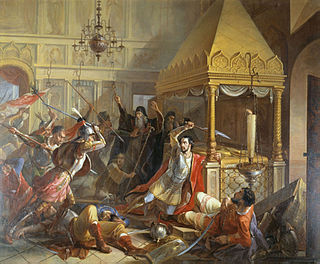
Okolnichy was an old Muscovite court official position. According to the Brockhaus and Efron Encyclopedic Dictionary, directives on the position of okolnichy date back to the 14th century. Judging by the Muscovite records from the 16th and 17th centuries, okolnichy were entrusted with the same business in administration as boyars, with the only difference that they were placed second to boyars everywhere. While lower than boyars, it was one of the highest ranks close to the tsar in the courts of the Moscow rulers until the government reform undertaken by Peter the Great.
Shamkhal, or Shawhal is the title for the rulers of Kumyk people in Dagestan and North-East Caucasus during the 8th-19th centuries. By the 16th Century, the state had its capital at Tarki and was thus known as the Shankhalate of Tarki.
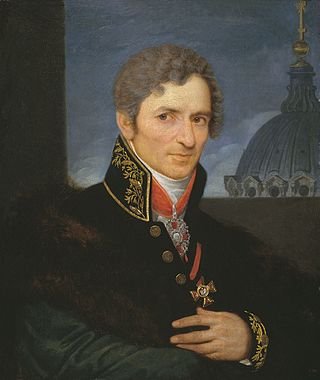
Andrey (Andrei) Nikiforovich Voronikhin was a Russian architect and painter. As a representative of classicism he was also one of the founders of the monumental Russian Empire style. Born a serf of the Stroganov family, he is best known for his work on Kazan Cathedral in Saint Petersburg.

Eugeny Vladimirovich Pchelov is a Russian specialist in history, heraldry and genealogy. He has published several monographs on the history, such as Rurikides. History of dynasty (2001), Romanov. History of dynasty (2001), Old Russian princely genealogy (2001), State symbols of Russia: Coat of Arms, Flag, Anthem (2007) and others.

The Shamkhalate of Tarki, or Tarki Shamkhalate was a Kumyk state in the eastern part of the North Caucasus, with its capital in the ancient town of Tarki. It formed on the territory populated by Kumyks and included territories corresponding to modern Dagestan and adjacent regions. After subjugation by the Russian Empire, the Shamkhalate's lands were split between the Empire's feudal domain with the same name extending from the river Sulak to the southern borders of Dagestan, between Kumyk possessions of the Russian Empire and other administrative units.

Blessed Be the Host of the Heavenly Tsar, also known as the Ecclesia militans, is a grand Russian Orthodox icon commemorating the conquest of Kazan by Ivan IV of Russia (1552).

The 1922 confiscation of church property in Russia was held by the Bolshevik government of the Russian Soviet Federative Socialist Republic allegedly to combat the Russian famine of 1921–1922. During 1922, precious metals and gems were removed by state authorities from churches of all denominations. Subject to confiscation or articles intended exclusively for liturgical purposes, which is set in a very vulnerable position of the clergy, and caused the resistance of the congregation. The clergy organized resistance to the removal and vandalization of church property, which was met with brutal repression by the Bolsheviks.
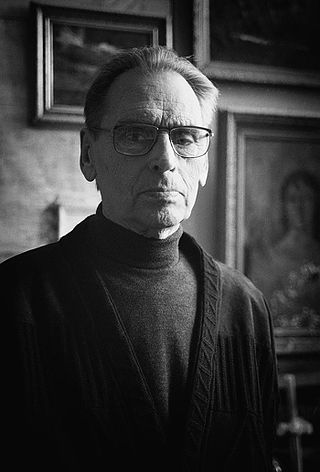
Lev Konstantinovich Bogomolets was a Soviet Russian painter, a member of the Saint Petersburg Union of Artists, who lived and worked in Saint Petersburg, regarded as one of representatives of the Leningrad school of painting, most famous for his landscape paintings.

The Kórmchaia Book, also known as the Books of the Pilot (Russian: Ко́рмчая книга, Ко́рмчая from кормчий, Church Slavonic: кръмьчии 'helmsman, ship's pilot'; Pidalion or Nomocanon, are collections of church and secular law, which constituted guide books for the management of the church and for the church court of Orthodox Slavic countries and were also the transmission of several older texts. They were written in Old Church Slavonic and Old East Slavic.
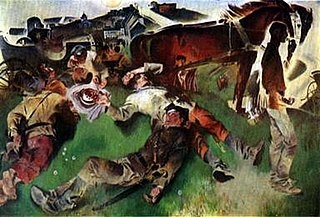
Cherry is an oil painting on canvas painted in 1969 by Russian artist Yevsey Moiseyenko (1916–1988).
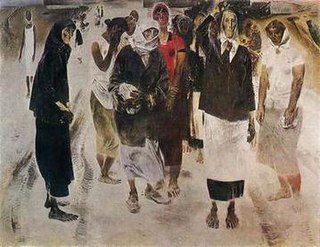
Mothers, Sisters is a painting by Russian artist Yevsey Moiseyenko (1916–1988).
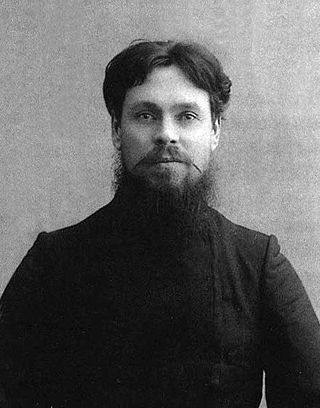
Ivan Gavrilovich Blinov was a calligrapher and miniaturist, bookmaking master, who worked in the traditional manner.
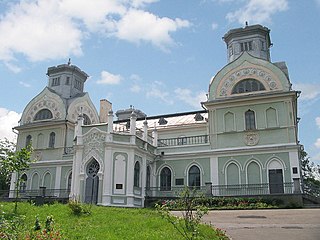
The Lopukhin family was a noble family of the Russian Empire, forming one of the branches of the Sorokoumov-Glebov family.

Boris Fedorovich Borzin was born in Ukraine on 29 December 1923 and died in Saint Petersburg, Russia in 1991. He was a Soviet realism painter, graphic artist, conservator, art historian, author, and a tenured professor of fine art for 30 years at the Herzen State Pedagogical University of Russia. Borzin was also a veteran of the Great Patriotic War.

Mikhail Hryhorovych Krivoshlyk, was a Russian Journalist, Writer, editor-publisher and State Councillor.
The Kobuzev family is an ancient Russian noble family descended from Ryazanian boyar scions.
Kumykia, or rarely called Kumykistan, is a historical and geographical region located along the Caspian Sea shores, on the Kumyk plateau, in the foothills of Dagestan and along the river Terek. The term Kumykia encompasses territories which are historically and currently populated by the Turkic-speaking Kumyk people. Kumykia was the main "granary of Dagestan". The important trade routes, such as one of the branches of the Great Silk Road, passed via Kumykia.

Joshua's Vision of St Michael or The Apparition of the Archangel Michael to Joshua is a 13th-century Russian icon. It is exhibited in Dormition Cathedral, Moscow. It shows an episode in Joshua 5.13-15 where "a man ... with a drawn sword in his hand" appeared to Joshua - that man was later interpreted as Michael the Archangel.

The Pozhalostin Ryazan Regional and State Art Museum is one of the oldest art museums in Russia. It houses about 12,000 items of Russian and Western Art, mainly paintings, graphics, sculptures, traditional arts and crafts, dating from the late 15th to the late 20th centuries. Its Western collection includes some works of the painters of the Flemish, French, and Italian schools, as well as porcelain items from English, German, and French manufacturers. A number of paintings, drawings, and sculptures, including several ancient icons, represent the museum's Russian Art collection. The works of Ryazan artists occupy an important part of the exposition.

















